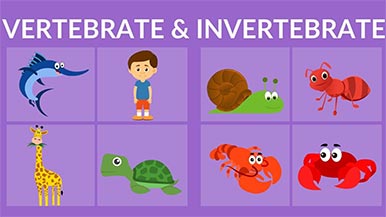Parenting(Age 5 to 8) | Academic | General | Parenting(Age 9 to 12) | Parenting(Age 13 to 16) | Nov 20, 2020
Classification of Vertebrates and Invertebrates

Living beings are classified based on a lot of things, ranging from their size to the habitat in which they thrive. However, if we have to give an exact distinction, it is the difference between the presence or, in some cases, absence of specific parts of the body. In general, animals can be divided into two categories, which are vertebrates and invertebrates. It can be confusing for some to understand these specific scientific terms and how to use them properly. So, without any delay, let’s dive in the details.
To put it in simple words, animals with a spine or an internal skeleton (bone structure) are vertebrates and animals without a spine or an internal skeleton are invertebrates. At first, it might seem like a very simple distinction, but the differences don’t end here. These two kinds are exactly opposite to each other in almost every aspect. To begin with, invertebrates have their skeletons on the outer side, also known as exoskeletons. It serves as a shield from the predators and other dangers. Animals like lobsters, spiders, ants, squids, snails etc. are considered as invertebrates. Their exoskeletons helps give shape to their body and also provides rigidity.
Invertebrates are also smaller in size when compared to vertebrates. What they lack in size, they make up in numbers, as almost 95% of the animals are invertebrates. If you look at the number of species that are currently known to mankind, that’s a large number. As invertebrates lack spinal cord, it means that they don’t have a complex nervous system. Their nervous system is unorganized as compared to the very complex nervous system and well organized organs of the vertebrates. The common examples of vertebrates are birds, fish, mammals, and lizards. As they possess a complex nervous system, it means the chances of them growing in size is higher as compared to invertebrates.
In humans, the spine is supporting the nervous system and is pivotal in joining all the organs within the body. Respiratory system is yet another example of how complex the mechanism is of vertebrates. The sensory organs in the vertebrates are also very complex and they are directly responsible to help adapting them according to the surroundings. The significant difference between the body structure of vertebrates and invertebrates is clearly visible by their body shape as well. Invertebrates can be of radial or bilateral shape while vertebrates are only bilateral. For the sake of simplification, just remember that radial body means that there are identical body halves around the central axis and bilateral means that the body has two sides, left and right.
Animals with radial symmetry will have top and bottom and animals with bilateral symmetry will have left and right. Animals with radial symmetry have the privilege of experiencing the environment equally from all sides. Animals with bilateral symmetry will have a head and tail, left and right, and top and bottom. As compared to radial symmetry, animals with bilateral symmetry can move faster and can concentrate on one direction at a time. This skill is highly useful while hunting.
In a nutshell, as diverse as animal kingdom may be, it all comes down to the internal and external structure of their body which can help us classify them.
Related Blog: Learn About the Fundamental Unit of Life – The Cell via Online Tutoring















Post a Comment: